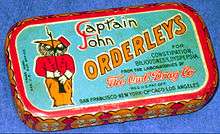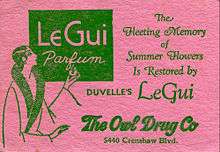The Owl Drug Company

The Owl Drug Company was an American drugstore retailer with its headquarters in San Francisco.[1] It was a subsidiary of Rexall stores[2] at its peak in the 1920s through 1940s. The founder of the Owl Drug Company was Richard Elgin Miller, R.E. Miller. The company sold medicines and pills, and later ventured into cosmetics, perfumes, and other goods. The firm organized "Beauty Weeks", which included a range of fashion-related entertainment such as beauty contests judged by Elinor Glyn, in which winners received a Hollywood screen test.
History

The Owl Drug Company was established in 1892 in San Francisco, at 1128 Market Street.[3] In 1903, with their contract with the Whitall Tatum Glass Company, they began making triangular, cobalt-blue bottles of various sizes to store poisons in, which was widely emulated.[4] According to the book Old Owl Drug Bottles & Others (1968), Owl Drug created a variety of bottles for prescription medicine and pills, and also soda bottles, with an owl sitting atop a mortar and pestle molded into the glass.[3] The bottles were produced in various sizes from .5 ounces (14 g) up to a (rarer) 32 ounces (910 g), over 10 inches (250 mm) in height. The bottles were also produced in other colors such as green, amber, and clear, and the logos on them often fluctuated from owls with a long tail to owls with no tail, with a short tail, with a potbelly, and others. These bottles are now collectors items, as are other company items such as tarot cards, receipts, advertising, stationary, calendars, and catalogs.[3]
In the late 1900s the main store at Mission and Sixteenth Streets was entirely rebuilt; it reopened in February 1910 with a soda fountain, one of the biggest in San Francisco at the time.[5]


Until the mid 1920s, the company bought their goods directly from E. R. Squibb & Sons, but the agreement ended following a bitter legal battle in 1926.[6][7] Elizabeth Winston Todd began working as a secretary for the firm in April 1929.[8] In January the firm announced a merger with United Drug Stores (Drug, Inc),[9] one of a plethora of companies to fall under its wing over the years.[10] In November 1931, the sub-manager of The Owl Drug Company placed $11,000 in the company safe, only to find all of it missing the next morning. The case was never solved.[11] The following year, Owl Drug Company filed for bankruptcy, an act which was described as a "sham, simply a device to defraud preferred stockholders and void burdensome leases".[12]
Despite filing for "bankruptcy", by the late 1930s the company had dozens of branches across the United States, operating in major cities like New York and Chicago, and especially in the Los Angeles area with branches at 6380-84 Hollywood Boulevard (at Cahuenga Boulevard) in Los Angeles from 1934,[13] between Sixth and Broadway, and at the intersection of Wilshire Boulevard and Western Avenue.[14] In Fresno, the company had a branch at the 1000 Fulton Mall Building on Fulton Street and Tulare Street from 1917 until 1951.[15] In San Diego they operated a large store next to the Plaza Hotel.[16] By the early 1940s they operated in Vancouver, Canada at Nelson Street and Granville Street.[17]
In October 1935 an employee of the company, Emma Bartholomai, suffered severe burns as the result of a fire which broke out in a false ceiling of a storeroom in the branch on Sixth and Broadway in Los Angeles; a worker of the Soule Steel Company had been welding in close proximity to the hazard. She took the company to court in 1940. The Bureau of Fire Investigation investigated the case and the court concluded in December 1940 that The Owl Drug Company had been negligent in permitting welding to have taken place, ruling: "The general rule is that persons in the lawful use of fire must exercise ordinary care to prevent it from injuring others".[18]
Baseball player Rugger Ardizoia worked for the firm in the late 1940s during off-seasons.[19] Cecil W. Law was chairman of the company for over 40 years.[20]
Other interests
As a company which also sold perfumes and cosmetics,[21] the Owl Drug Company ran "Beauty Weeks", which included a range of fashion-related entertainment including beauty contests judged by Elinor Glyn, in which winners received a Hollywood screen test.[22] Their fashion shows were a considerable success and attracted many people.[23]
In the mid 1940s, the firm sponsored a San Francisco-based baseball team, known variously as the Portola Natives or Portola Merchants; the team temporarily called itself "The Owl Drugs Juniors". By 1949 it was no longer being sponsored by Owl Drugs but by the Theisen Glass Company.[24]
References
- ↑ Longstreth, Richard W. (1998). City Center to Regional Mall: Architecture, the Automobile, and Retailing in Los Angeles, 1920-1950. MIT Press. p. 3. ISBN 978-0-262-62125-0.
- ↑ Billboard. Nielsen Business Media, Inc. 11 January 1947. p. 95. ISSN 0006-2510.
- 1 2 3 "The Owl Drug Company". Bergsengs.com. Retrieved 10 August 2014.
- ↑ Griffenhagen, George B.; Bogard, Mary (1999). History of Drug Containers and Their Labels. Amer. Inst. History of Pharmacy. p. 95. ISBN 978-0-931292-26-2.
- ↑ "Owl Drug Company Opens New Store". San Francisco Call, Volume 107, Number 74, 12 February 1910, accessed via the California Digital Newspaper Collection. Retrieved 10 August 2014.
- ↑ Printers' Ink. Printers' Ink Publishing Company. 1926. p. 93.
- ↑ The National Druggist. H. R. Strong. 1926. p. 514.
- ↑ Purcell, Aaron D. (2 March 2011). White Collar Radicals: TVA's Knoxville Fifteen, the New Deal, and the McCarthy Era. Univ. of Tennessee Press. p. 36. ISBN 978-1-57233-683-4.
- ↑ Lillard, Benjamin (1930). Practical Druggist and Pharmaceutical Review of Reviews. Lillard & Company. p. 59.
- ↑ LIFE. Time Inc. 5 August 1946. p. 92. ISSN 0024-3019.
- ↑ Michel, Fabre,. The World of Richard Wright. Univ. Press of Mississippi. p. 93. ISBN 978-1-61703-517-3.
- ↑ Raymond, C. Elizabeth (1992). George Wingfield: Owner and Operator of Nevada. University of Nevada Press. p. 232. ISBN 978-0-87417-197-6.
- ↑ Winter, Robert (1 September 2009). An Arch Guidebook to Los Angeles. Gibbs Smith. p. 181. ISBN 978-1-4236-0893-6.
- ↑ Wilson, Chris; Groth, Paul Erling (2003). Everyday America: Cultural Landscape Studies After J.B. Jackson. University of California Press. p. 294. ISBN 978-0-520-22961-7.
- ↑ "1000 Fulton Mall Building, Owl Drug Store, Fulton Street and Tulare Street, Fresno, CA". Pacific Coast Architecture Database. Retrieved 10 August 2014.
- ↑ "San Diego Historical Society (photograph)". accessed via cdn.calisphere.org. Retrieved 10 August 2014.
- ↑ "Item : CVA 371-868 - The awning for The Owl Drug Company Limited at the corner of Nelson Street and Granville Street". City of Vancouver Archives. Retrieved 10 August 2014.
- ↑ "Bartholomai v. Owl Drug Co. 42 Cal. App. 2d 38". Civ. No. 12101. Second Appellate District, Division One. December 17, 1940., accessed via Justia US Law. Retrieved 10 August 2014.
- ↑ Bridging Two Dynasties: The 1947 New York Yankees. Society for American Baseball Research, U of Nebraska Press. 1 April 2013. p. 71. ISBN 0-8032-4609-9.
- ↑ Gigliotti, Linda (2002). Flight Into Yesterday. Trafford Publishing. p. 288. ISBN 978-1-55212-989-0.
- ↑ Codori, Jeff (28 February 2012). Colleen Moore: A Biography of the Silent Film Star. McFarland. p. 154. ISBN 978-0-7864-8899-5.
- ↑ Finamore, Michelle (30 January 2013). Hollywood Before Glamour: Fashion in American Silent Film. Palgrave Macmillan. p. 163. ISBN 978-0-230-38948-9.
- ↑ Deverell, William (2004). Whitewashed Adobe: The Rise of Los Angeles and the Remaking of Its Mexican Past. University of California Press. p. 239. ISBN 978-0-520-21869-7.
- ↑ Garibaldi, Rayna (25 April 2007). San Francisco's Portola. Arcadia Publishing. p. 120. ISBN 978-1-4396-3407-3.
External links
| Wikimedia Commons has media related to The Owl Drug Company. |
- The Owl Drug Handbook Volumes I and II
- Bottledigging.org.uk - forum article